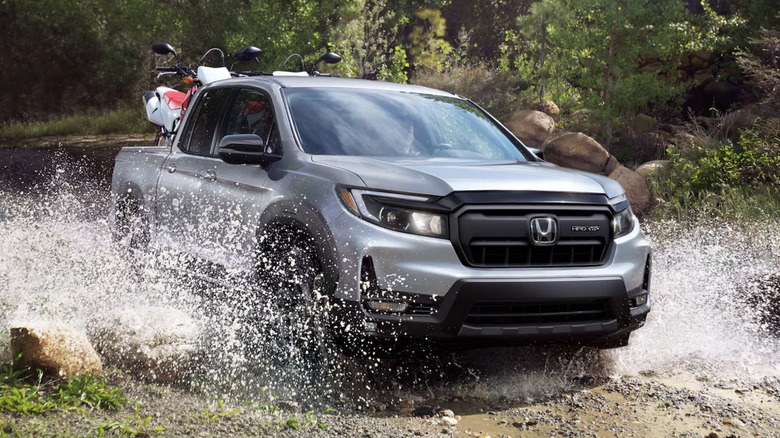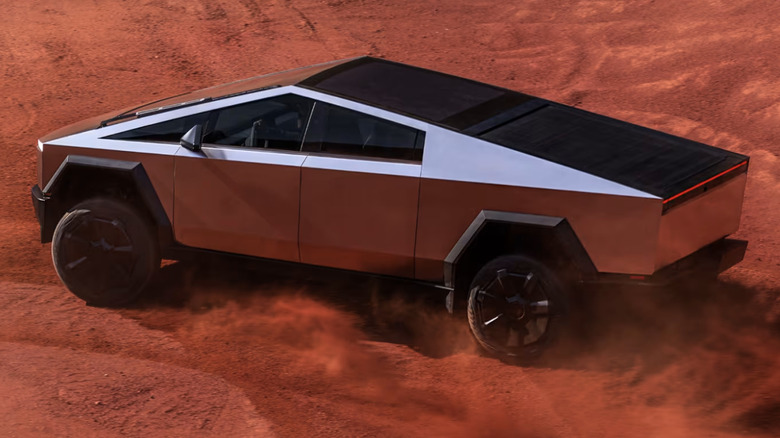Why You Shouldn't Count Out These Notoriously Ugly Trucks
Automotive design history has many highlights, from the stunning first-generation Ford Thunderbird to our ten coolest cars from the 2024 model year. There have been plenty of notable duds, too, like the before-its-time Pontiac Aztek and the malformed Youabian Puma. Pickup trucks are not exempt from the latter category, although some pickups that might be repulsive at first glance are sleepers in disguise, hiding features that grow on you as you get to know them better.
Some of the trucks on this list are more familiar than others, but none of them will inspire oohs and aahs should you happen upon one in a grocery store parking lot or school pick-up line. But at SlashGear, we pride ourselves on finding hidden gems. Read on to learn more about a handful of trucks that might inspire groans at first look but have something to offer you under their not-so-attractive surface layers.
The Honda Ridgeline is dull but dependable
The 2025 Honda Ridgeline is by no means the ugliest truck on the market — or even the ugliest Ridgeline ever made — but it is wholly unremarkable from a design standpoint. It looks like it was crafted by a committee of design wonks who were tasked with producing the most nondescript design possible, and it's indistinguishable from every truck from the last 8 years or so, save for the giant silver "H" on the grille.
The Ridgeline is clad in cheap-looking black plastic from tip to tail, and the deep creases on the hood and along the sides make it look like the design team forgot to come back after lunch to finish smoothing out the Ridgeline's look. These aesthetic violations hide what is overall a decent machine underneath. Our Chris Davies reviewed the 2024 Ridgeline Trailsport and found it to be a good compromise between suburban go-getter and off-road fun machine, concluding that it was "a solid, commendable truck."
The Subaru Brat is ugly, economical fun
Subaru tried to join the American ute craze in 1978 by slapping a pickup bed on the back end of the Leone and calling it the BRAT, or "Bi-drive-Recreational All-terrain Transporter." It was aimed at the Chevy El Camino, which disappeared from the market in 1987 along with the BRAT. The BRAT was sold in Oceania, Latin America, and Europe under an array of alternate badges, although a lack of demand for utes in Japan kept it out of its home market.
The BRAT is one of those vehicles that — like the Aztek — has gained a fan base with age and hindsight. The three four-cylinder engines offered during the BRAT's run maxed out at 1.8 liters and 95 horsepower. That was anemic for a time when displacement and dynamometer numbers still ruled. Now that efficiency is king, the BRAT's advertised fuel economy numbers of 25 miles per gallon in the city and 34 on the highway (which aren't bad by modern standards) look epic for its time. The BRAT is also as cheap to acquire today as it was to operate when new. Classic.com shows an average transaction price of $15,502 over the past five years, with ten BRATs going for $10,000 or less.
[Featured image by Sicnag via Wikimedia Commons|Cropped and scaled|CC-BY SA 2.0]
The Cadillac Mirage is a rare bird, so grab one if you can
The '70s were a wild time, and even Cadillac's designers got dragged into the "let's make a ute" muck for a few brief years during this forgettable decade. From 1973 through 1976, GM's luxury division sold the Mirage, a pickup version of the Coupe De Ville built by Traditional Coach Works. The decidedly untraditional design saw a limited run of only about 200 units, and for those of us with functioning eyeballs, that's probably a good thing.
Legendary stuntman Evel Knievel bought the first Mirage. He had a thing for converted Cadillac pickups and owned at least one other similar monstrosity in a bright reddish-orange. If kitsch and owning a rare piece of forgotten history are your thing, you might want to see if you can find one of the few Mirages still circulating. Classic.com shows only five sales in the past five years, ranging from just over $7,000 to just under $50,000 and averaging exactly $31,690.
The Toyota Tundra is a plain-Jane workhorse
Toyota can be forgiven for making an ugly truck that functions as well as the 2025 Tundra. The world's best-selling car company for the last four straight years does lose a few points for giving the drab shade called "Mudbath" top billing on its website. The latest version of the full-sized pickup marks the Tundra's 25th year over three generations, though, so we'll let that poor advertising choice and the blocky exterior slide until the next redesign of the truck and the site.
If you can look past the "just-like-every-other-pickup" outer shell, the Tundra offers as much as 437 horsepower and 583 pound-feet of torque from the iForce Max hybrid powertrain, and a peak towing capacity of 12,000 pounds. There's a 14-inch infotainment screen and 12.3-inch digital dashboard to feed you information from the available trailer backup guidance and other driver assist systems, and some of the Tundra's ten trim packages come with power adjustable seats or off-road ready wheels and suspension components. The Tundra starts at just over $40,000, making it one of the more accessible full-sized pickups on the market.
The polarizing Cybertruck has probably passed its low point
The Tesla Cybertruck has brought derision since its debut. Some of those jeers came during the delayed development and rollout process, others were earned at the Cybertruck's rocky unveiling, and still more came once the truck actually hit the market. There have been issues with substandard construction, multiple recalls, and speculation that the model might be scuttled altogether.
Despite those numerous and serious hiccups, the Cybertruck has a fierce fanbase of Tesla and Elon Musk loyalists, who have singlehandedly kept the market for the silver wedge alive. The Verge reported that registrations of new Cybertrucks for July nearly matched those for every other electric truck combined, helping Tesla capture nearly half of all new EV registrations for the month. A report from Inside EVs from about a year ago estimated that there were about two million people waiting for backordered Cybertrucks, a backlog that will take years to fill. That report may not be spot-on, but there is certainly demand for the unique EV, and Tesla's strong sales of its other models ensure that it has money to continue to develop and produce the Cybertruck despite any setbacks.
If Tesla can resolve the battery supply and build quality issues and bring the Cybertruck's price down from its current level of $81,195 and up, it might repair the model's iffy reputation among Cyberskeptics. And as we get more accustomed to seeing the stainless steel polygons on city streets, they'll become less of a puzzling novelty and more acceptable to mainstream buyers.





